-
Product Management
Software Testing
Technology Consulting
-
Multi-Vendor Marketplace
Online StoreCreate an online store with unique design and features at minimal cost using our MarketAge solutionCustom MarketplaceGet a unique, scalable, and cost-effective online marketplace with minimum time to marketTelemedicine SoftwareGet a cost-efficient, HIPAA-compliant telemedicine solution tailored to your facility's requirementsChat AppGet a customizable chat solution to connect users across multiple apps and platformsCustom Booking SystemImprove your business operations and expand to new markets with our appointment booking solutionVideo ConferencingAdjust our video conferencing solution for your business needsFor EnterpriseScale, automate, and improve business processes in your enterprise with our custom software solutionsFor StartupsTurn your startup ideas into viable, value-driven, and commercially successful software solutions -
-
- Case Studies
- Blog
A Guide to Telehealth Market Analysis: Finding a Market Niche
The telehealth app market has become highly competitive, with over 250 apps launched every day. Having a unique app idea is no longer enough to stand out from the competition. If you start developing your doctor appointment app unprepared, you’re sure to face many challenges and may even end up among the 90% of startups that fail. However, if you spend time preparing all components of the app development process beforehand, it will be easier for you to create a commercially successful telehealth solution that lasts for many years to come.
If you’re a startup CEO who has a great doctor appointment app idea but doesn’t know if your solution would be relevant for customers, our article for you.
We’ve conducted telehealth market analysis for startup owners engaged in doctor appointment app development. Now, we want to show you why doctor appointment apps are in high demand on the telehealth market. Additionally, we’ll provide you with a brief competitor analysis and buyer persona profiles based on an analysis of a typical target audience. Finally, you’ll be able to download a sample business model – your helpful guide to doctor appointment app development.
Why is telehealth market analysis vital?
Lack of product–market fit and a flawed business model are the top reasons why most startups fail, and these are a result of poor market investigation.
Many would-be entrepreneurs enter the telehealth market with a strong belief in the exclusiveness of their offer that is not supported by facts. This may lead to entrepreneurs entering the wrong market, targeting the wrong audience, or even offering a product nobody needs.
To minimize the risk of failure, start with a telehealth market analysis. Additionally, review competitors and the target audience of your future doctor appointment app.
Telehealth market analysis
The telemedicine market is demonstrating rapid growth, with more people using telemedicine services all the time. Consequently, demand for telemedicine software is also on the rise. Look at key points of our telehealth market analysis to decide whether developing a doctor appointment app is a promising startup business idea.
Growth in telehealth market size and boom in investments
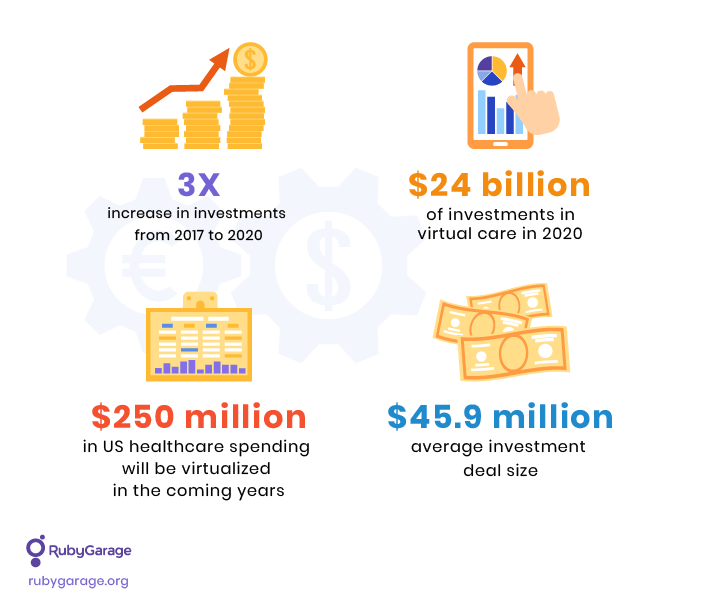
- The size of the global app booking software market is estimated to rise from $205.85 million in 2018 to $546.31 million by 2026, demonstrating 13.1 percent CAGR from 2019 to 2026. (Allied Market Research)
- Thanks to the rapid adoption of telemedicine services among doctors and patients, $250 billion in US healthcare spending is estimated to be virtualized in the coming years. (McKinsey)
- In 2020, investments in digital health tripled compared to 2017. (McKinsey)
- The total revenue of the top 60 telehealth providers increased from $3 billion in 2019 to $5.5 billion in 2020. (McKinsey)
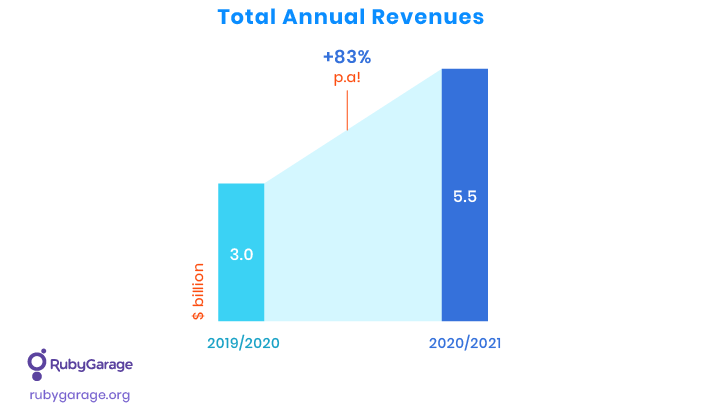
- Within less than ten years, most healthcare organizations will deliver telehealth services to their patients on a regular basis. (IQVIA)
- 85 percent of hospitals and private clinics will invest in telemedicine in the coming years; 84 percent plan to cover new areas and expand their reach. (McKinsey)

- In 2020, investments in virtual care amounted to $24 billion and included a significant rise in mergers and acquisitions. In 2021, the average deal size reached $45.9 million, demonstrating a rise compared to 2020, when it amounted to $31.7 million. (IQVIA)
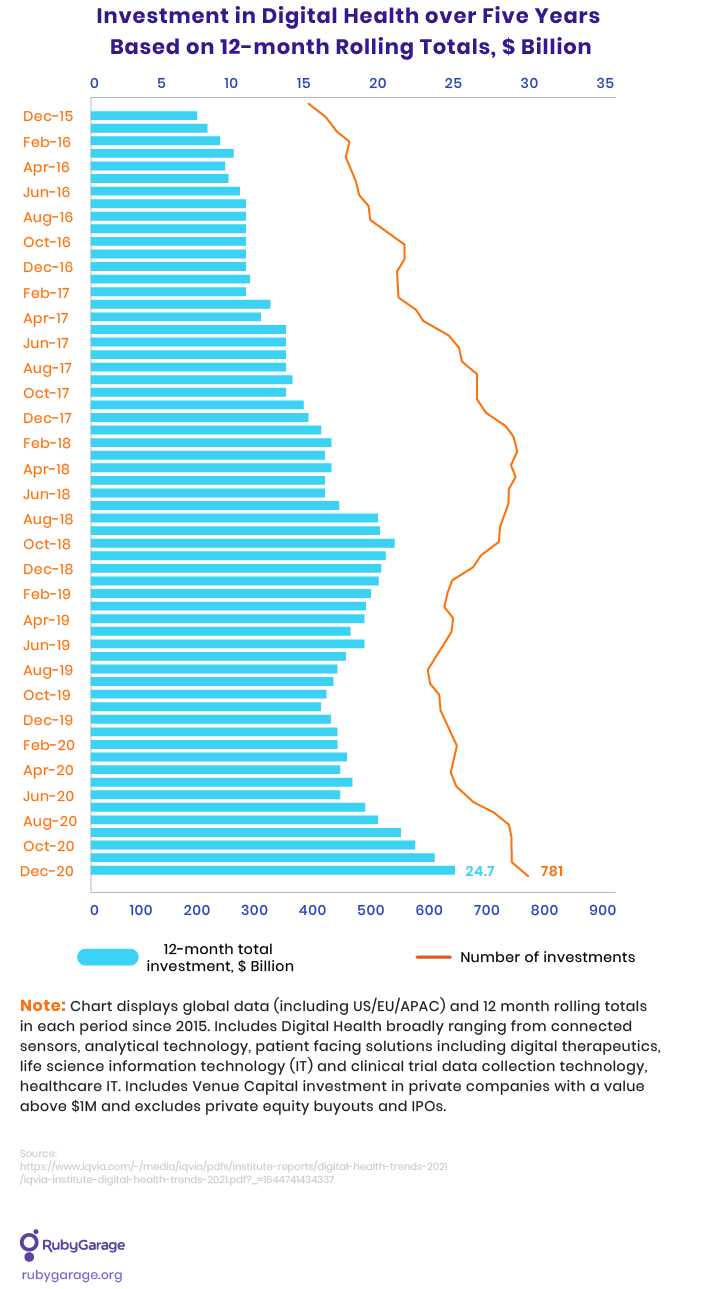
Telemedicine adoption by demographic group
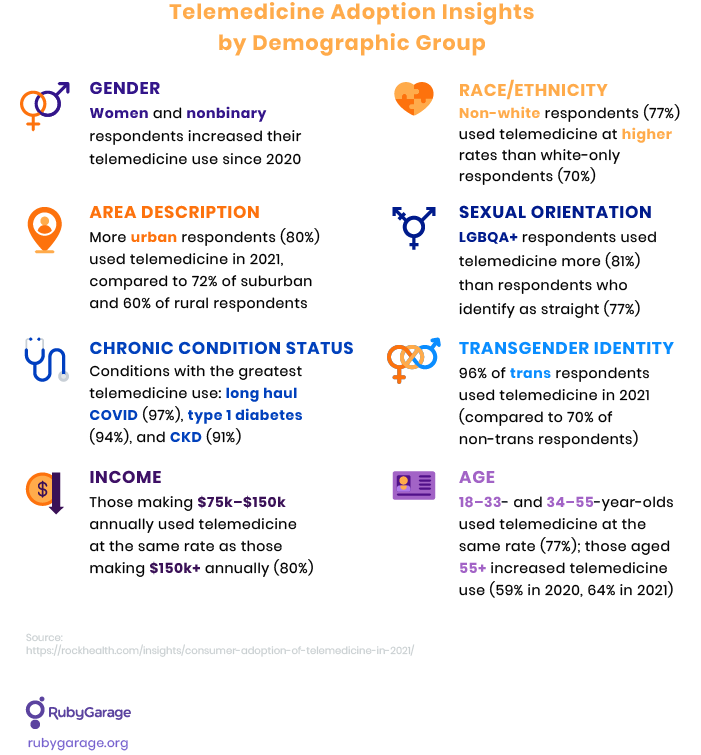
Rapid adoption among doctors and patients
- As of spring 2021, 84 percent of doctors surveyed offered virtual consultations, and 54 percent were willing to continue their virtual practice after the pandemic. (McKinsey)
- The percentage of US patients using telehealth services skyrocketed from 11 percent in 2019 to 46 percent in 2020. (McKinsey)
- In 2020, medical specialists gave 50 to 175 times the number of online consultations they offered in previous years. (McKinsey)
- Of the doctor appointment cancellations that happened in the period from March 15, 2020 to May 1, 2020, VA hospitals in the United States managed to convert around 1.1 million of them to phone or video appointments. (Department of Veterans Affairs)
- 73% of patients who have already tried telemedicine services plan on using them at the same rate or a higher rate in the near future. (Rock Health)
- The desire to schedule appointments online has increased among people of different age groups, with a significant rise being observed among Millennials (28 percentage point increase between 2019 and 2020). Besides, 61 percent of respondents are ready to switch telehealth service providers in order to schedule appointments online. (Kyruus)

Rising interest in online appointment scheduling solutions
- 74 percent of patients who schedule a doctor appointment prefer providing all check-in information via an online chat. (Accenture)
- When patients select a new service provider, they consider location and appointment availability the top criteria influencing their decision. Thus, 60 percent of patients say that access to virtual consultations will affect their choice of care provider in the future. (Kyruus)
- Though most people still book their virtual medical appointments by phone, 54 percent of patients say they would prefer scheduling their future visits online. 72 percent of Gen Xers and 64 percent of Millenials prefer online scheduling. Besides, 65 percent of patients with commercial insurance and 45 percent of patients with non-commercial insurance are ready to book appointments online. (Kyruus)
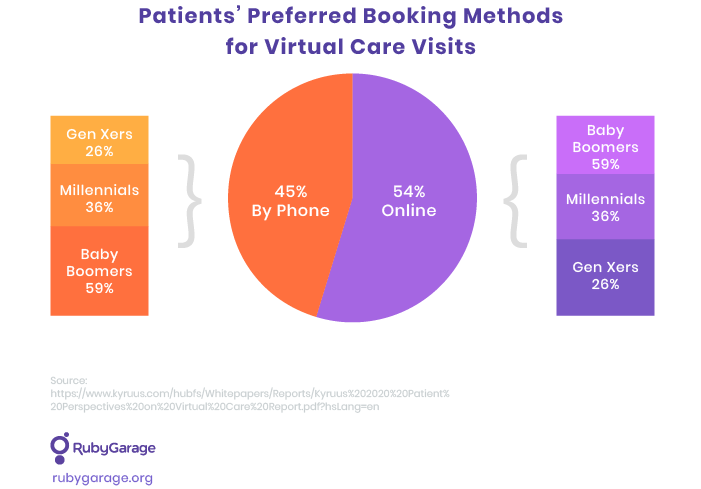
The telemedicine market demonstrated rapid growth in 2020. Demand for telehealth services is increasing, doctors are adding remote consultations to their daily operations, and patients are enjoying technological advances and the convenience of telemedicine. The market will continue to grow in the coming years, with more investments being made in healthcare solutions. Right now, you have a chance to carve out a niche in the expanding telehealth market and develop an innovative doctor appointment app that will improve people’s lives and bring you high revenue.
Competitor analysis
Once you’ve finished a telehealth market analysis for your startup, conduct a competitor analysis to determine a competitive rate in your niche, key market players, their value propositions, and features they lack. Then, use this knowledge to choose a gap in the niche that can be filled with your app, avoid competitors’ mistakes, and define your customers’ main problem and the solution you’re going to offer.
The State of Digital Patient Access report by Kyruus shows that the top 20 US hospitals already offer their current patients mobile apps for virtual care. At the same time, only one-third of these hospitals let new patients schedule doctor appointments without prior account registration.
The number of digital health apps is actively growing, with over 350,000 health and wellness or medical apps already offered to customers worldwide. In 2020, over 91,000 new health & wellness and medical apps became available in the App Store and Google Play Store — 251 apps per day.
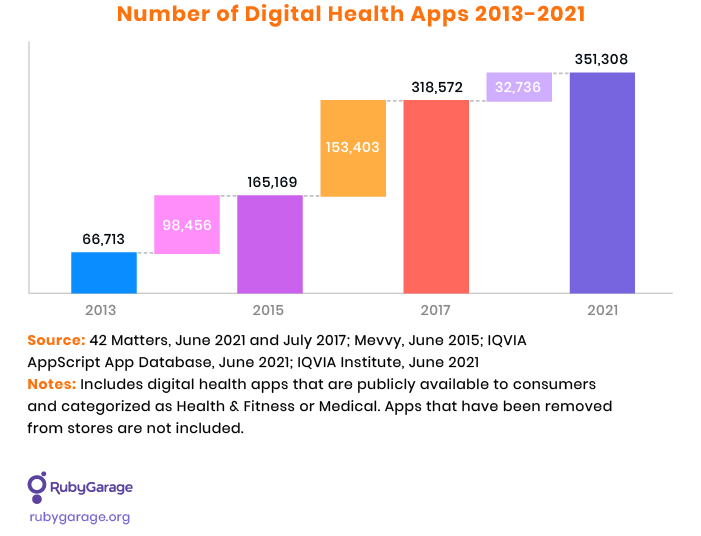
Despite rising competition on the telehealth market, the mismatch between patient demand and available doctor appointment scheduling solutions offers a chance for your startup business idea to be successful.
With many applications on the market, we’ll look at the top three competitors: Zocdoc, Doctor on Demand, and Practo. Analyzing these solutions will help you understand what advantages you can offer your future users.

Target audience analysis
Carry out consumer research to analyze your target audience and identify your typical users. This will help you determine what functionality your app should include to address users’ pain points and meet users’ needs.
For developing your doctor appointment app, you need to create a physician persona and a patient persona, which may look as follows.


Pro tip: To familiarize yourself with the product discovery process, its steps, and its results, read our article How to Conduct Product Discovery Process in 4 Steps.
A business model for doctor appointment app development
Unlike developing a business plan, creating a business model using a lean canvas helps you quickly evaluate your startup business idea. You can fill out a simple template focused on the problem–solution fit to see if your product will efficiently solve your audience’s pain points.
Though the details of your lean canvas for a doctor appointment app may differ depending on your product’s functionality, it will generally look as follows.
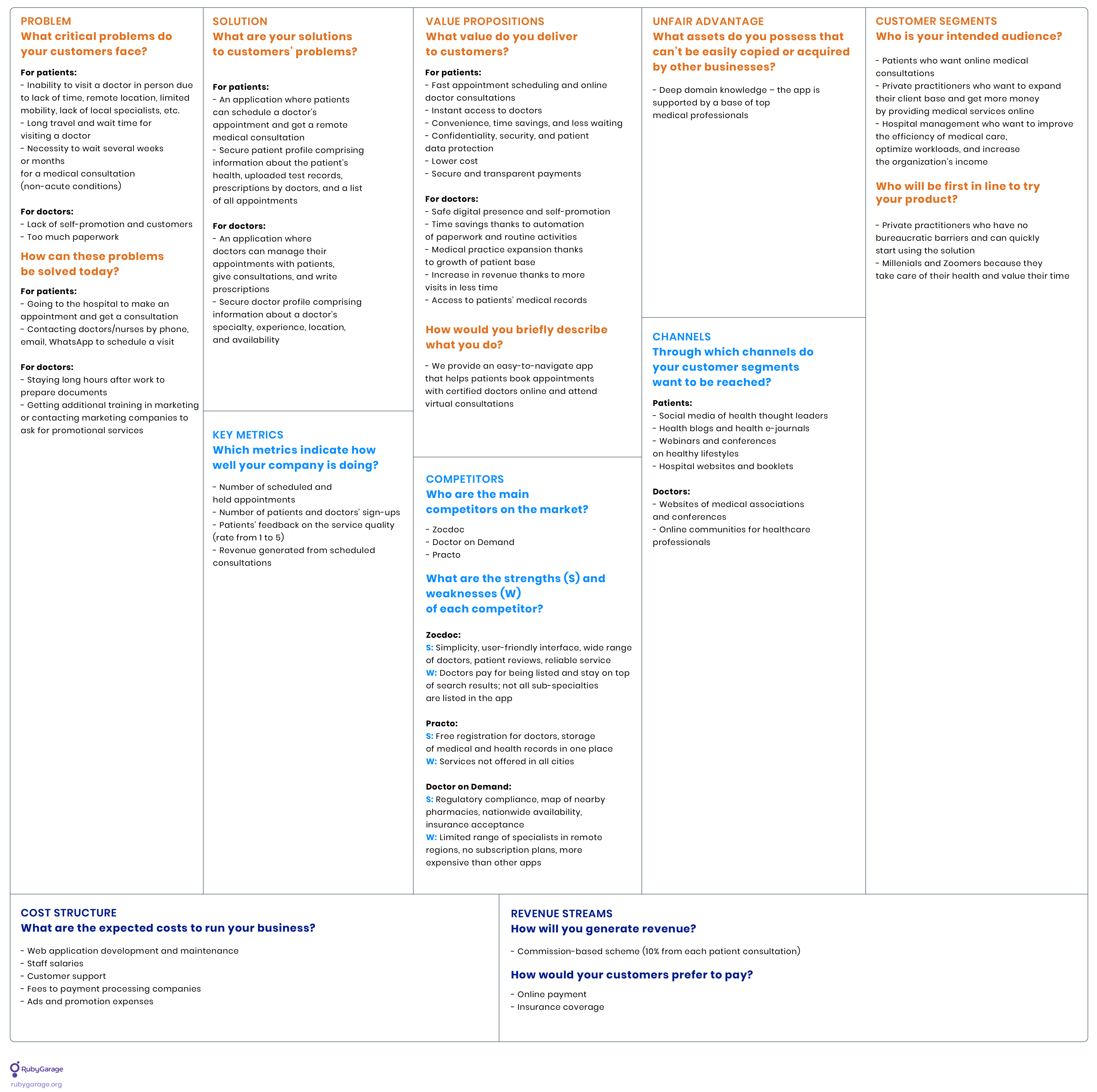
Pro tip: Read our article How and Why We Evaluate Our Clients' Business Ideas to find out why evaluating the business idea of a technology startup is a crucial step for a development team.
What’s next?
Once you’ve done telehealth market analysis for your doctor appointment app and developed buyer personas and a business model, you’ve already done a significant portion of work. Now you may proceed to other steps of the doctor appointment app development process, including:
- Compiling a list of features for your app
- Preparing your database of doctors
- Designing and developing your prototype
- Coding and testing your doctor appointment app
- Releasing, maintaining, and improving your app
How RubyGarage can help
If you need any help conducting a telehealth market analysis, verifying your business idea, creating your business plan, or developing an innovative healthcare app, you can always count on us.
RubyGarage is a trusted software development company specializing in building solutions for the healthcare industry. With many successful telemedicine projects for hospitals and private clinics in our portfolio, we can provide you with expert consultations on any app-related questions and offer software development services that meet your specific needs.
Learn more about healthcare solutions we can help you with.
FAQ
-
Lack of product–market fit and a flawed business model are the top reasons why most startups fail, and these are a result of poor market investigation. Many would-be entrepreneurs enter the telehealth market with a strong belief in the exclusiveness of their offer that is not supported by facts. This may lead to entrepreneurs entering the wrong market, targeting the wrong audience, or even offering a product nobody needs. To minimize the risk of failure, start with a telehealth market analysis.
-
The telemedicine market demonstrated rapid growth in 2020. Demand for telehealth services is increasing, doctors are adding remote consultations to their daily operations, and patients are enjoying technological advances and the convenience of telemedicine. The market will continue to grow in the coming years, with more investments being made in healthcare solutions.
-
Creating a business model using a lean canvas helps you quickly evaluate your startup business idea. You can fill out a simple template focused on the problem–solution fit to see if your product will efficiently solve your audience’s pain points.










